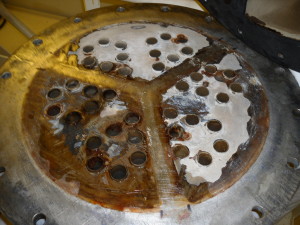Fouling of Cooling Water Tubes in a Condenser
- Posted on 29th December 2013
- in Condensor
- by Jan de Geest
 GLM Hydro Condensor Problem Solving: – There is one thing that many falling film- and forced circulation evaporators running under vacuum conditions have in common, the use of a condenser at the end of the evaporation system to condense the final vapors.
GLM Hydro Condensor Problem Solving: – There is one thing that many falling film- and forced circulation evaporators running under vacuum conditions have in common, the use of a condenser at the end of the evaporation system to condense the final vapors.
Where undesired air leaks are the 1st most common problem, the ability for the condenser to take the final energy load might be the 2nd. Often you see that at the same cooling water flow and energy load on the condenser, the cooling water does not have the temperature rise anymore. The energy of the boiling vapors is not absorbed by the cooling water, leading to higher evaporator temperatures and pressures.
Cooling Water Fouling
Often the cooling water has a hardness to it that will result in a layer of fouling on the condenser tube wall over the years. I also have seen cooling water tubes fouled severely by algae’s in the water. It all depends on the velocity through the tubes-, quality-, temperatures- of your cooling water.
If the layer of built up becomes thick enough the heat transfer through the fouling layer at some point will give you a problem. I have seen different types of fouling, organic and in-organic and often a combination thereof, depending on the source of the cooling water. It is important to know what type of fouling you have and which cleaning solutions and cleaning cycles are most effective.
Velocity
A lot of customers make connections on the cooling water inlet and outlet nozzle, so they can hook up hoses, a pump and a container of cleaning liquid to perform a cleaning in place (CIP) once a year. You have to keep in mind however, that for a good CIP you need a minimum velocity to make the flow turbulent. As a rule of thumb around 6 ft/s velocity will work best. If you run on a reduced flow you will not get an optimum effect and the CIP becomes more soaking, which may clean the tubes if you are lucky. At low velocities you may not have enough driving force to really remove the scaling.
For organic fouling you need an alkaline solution, for in-organic an acid solution. Make sure that you run your cleaning on the optimum concentration. Concentrations in the range of 0.8% for alkaline and 1.0% for acidic solutions. The optimum temperature range lays normally between 140 and 170 °F. Your cleaning solution supplier should be able to give you a range of the most effective solutions, concentrations and temperatures.
Make sure you check the suitability of the cleaning solution on the materials your condenser is made of such as the tubes, covers, piping and gaskets. Remember there are companies out there that offer these kinds of cleaning services, they have the equipment to do this safe and proper for you.
Contact us for more information when your installation has these or any other kind of issues.
- Calcium Fouling in Barometric Leg of a Direct-Contact Condensor - October 19, 2020
- GLM Luebbers - January 14, 2020
- Capacity Improvement of your Existing Falling Film Evaporator with a Potential Increase on the Dryer Output - January 18, 2014
Tags: Condensor, falling film, Falling Film Evaporator, Forced Circulation Evaporator, vacuum
